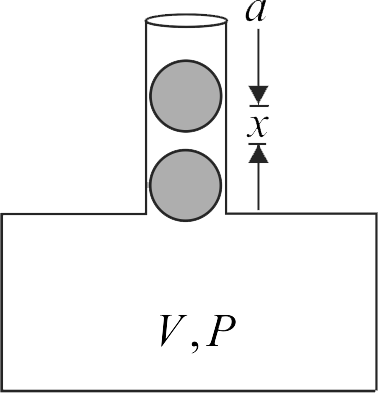364161 An air chamber of volume \(V\) has a neck of crosssectional area \('a'\) into which a light ball of mass ' \(m\) ' just fits and can move up and down without friction. The diameter of the ball is equal to that of the neck of the chamber. The ball is pressed down a little and released. If the bulk modulus of air is \(B\), the time-period of the oscillation of the ball is \(2\pi\,\,{m^x}{V^y}{B^z}{a^q}\). The value of \(\frac{{xy}}{q}\) is
364161 An air chamber of volume \(V\) has a neck of crosssectional area \('a'\) into which a light ball of mass ' \(m\) ' just fits and can move up and down without friction. The diameter of the ball is equal to that of the neck of the chamber. The ball is pressed down a little and released. If the bulk modulus of air is \(B\), the time-period of the oscillation of the ball is \(2\pi\,\,{m^x}{V^y}{B^z}{a^q}\). The value of \(\frac{{xy}}{q}\) is
364161 An air chamber of volume \(V\) has a neck of crosssectional area \('a'\) into which a light ball of mass ' \(m\) ' just fits and can move up and down without friction. The diameter of the ball is equal to that of the neck of the chamber. The ball is pressed down a little and released. If the bulk modulus of air is \(B\), the time-period of the oscillation of the ball is \(2\pi\,\,{m^x}{V^y}{B^z}{a^q}\). The value of \(\frac{{xy}}{q}\) is
364161 An air chamber of volume \(V\) has a neck of crosssectional area \('a'\) into which a light ball of mass ' \(m\) ' just fits and can move up and down without friction. The diameter of the ball is equal to that of the neck of the chamber. The ball is pressed down a little and released. If the bulk modulus of air is \(B\), the time-period of the oscillation of the ball is \(2\pi\,\,{m^x}{V^y}{B^z}{a^q}\). The value of \(\frac{{xy}}{q}\) is
